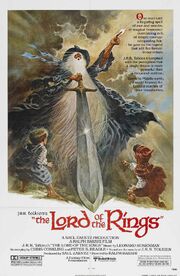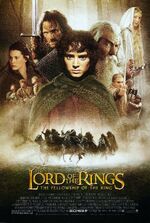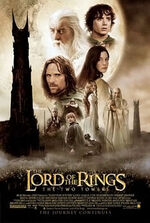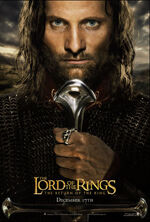| After Tolkien |
|---|
| Secondary literature |
| Adaptations |
| Works inspired by |
| Popular culture |
For four decades there have been numerous adaptations to The Lord of the Rings, set in Middle-earth.
Film
Three film adaptations of The Lord of the Rings have been made. The first was The Lord of the Rings (1978), by animator Ralph Bakshi, the first part of what was originally intended to be a two-part adaptation of the story. The second, The Return of the King (1980), was released as a television special by Rankin-Bass. These films were remade by director Peter Jackson in The Lord of the Rings film trilogy, released in three installments as The Lord of the Rings: The Fellowship of the Ring (2001), The Lord of the Rings: The Two Towers (2002), and The Lord of the Rings: The Return of the King (2003).
Early efforts
In the mid-1970s, film director John Boorman collaborated with current film rights holder and producer Saul Zaentz and corresponded with Tolkien about a live action picture, which was supposedly more to the author's liking than an animated film. Produced by United Artists, it would have been one long film with an intermission.[1]
In the script, written by Boorman and his colleague Rospo Pallenberg, many new elements were inserted or were modified. The first half is largely based on The Fellowship of the Ring. Following the intermission, the writers "dropped things out" and "invented as they went along".[1] Among other things, Frodo and the Lady Galadriel have sexual intercourse (her husband Celeborn is omitted), the Lord of the Nazgûl rides a bleeding, skinless horse in lieu of a flying pterodactylic creature, Gimli is put in a hole and beaten so he can retrieve the password to Moria from his ancestral memory, and Arwen is made into a spiritual guide for the Fellowship and her role as Aragorn's love interest is wholly transferred to Éowyn, who becomes the latter's queen.[2]
The project ultimately proved too expensive to finance at that time. Boorman ended up making the Arthurian epic Excalibur instead, also with Pallenberg's help - where in a draft for that movie’s script they use similar concepts; a "duel of words" originally planned between Gandalf and Saruman becomes a duel between Merlin and Morgana, albeit rephrased. This duel as written does not appear in the final film.[2] A copy of the script is stored in the Tolkien papers collection of Marquette University.[3]
In 1977, Rankin-Bass studios produced the first real film adaptation of any of Tolkien's works with an animated television version of The Hobbit.[4]
Animated films
- Main article: The Lord of the Rings (1978 film)

Ralph Bakshi's The Lord of the Rings
In 1978, shortly after the Rankin-Bass animated television film of The Hobbit, Saul Zaentz produced an animated adaptation of The Fellowship of the Ring and part of The Two Towers.[5] The Lord of the Rings Part 1 (later J. R. R. Tolkien's The Lord of the Rings), originally released by United Artists, was directed by Ralph Bakshi and used an animation technique called rotoscoping in which footage of live actors was filmed and then traced over.[6]
The film was part one of what was originally to be a two-part adaptation of Tolkien's story, Part I ending after the battle of Helm's Deep, but before Sam, Frodo and Gollum traverse the Dead Marshes, and Part II picking up from where the first left off. Made for a minimal budget of US$8 million, the film made over US$30 million dollars at the box office.[7] However, United Artists viewed the film as a flop, and refused to fund a Part II (covering the rest of the story), leaving the door open for Rankin-Bass to do the work for him with the 1980 animated television version of The Return of the King.[8]
New Line Cinema films
- Main article: The Lord of the Rings film trilogy

Peter Jackson's The Lord of the Rings: The Fellowship of the Ring
Miramax Films developed a full-fledged live action adaptation of The Lord of the Rings, with Peter Jackson as director. Eventually, with Miramax owner Disney becoming increasingly uneasy with the sheer scope of the proposed project, Jackson was given the opportunity to find another studio to take over. In 1998, New Line Cinema assumed production responsibility (while Miramax executives Bob Weinstein and Harvey Weinstein retained on-screen credits as executive producers). The three films were shot simultaneously. They featured extensive computer-generated imagery, including major battle scenes utilising the "Massive" software program. The Lord of the Rings: The Fellowship of the Ring was released on December 19 2001, The Lord of the Rings: The Two Towers on December 18 2002 and The Lord of the Rings: The Return of the King worldwide on December 17 2003. All three won the Hugo Award for Best (Long-form) Dramatic Presentation in their respective years.
The films were met with both critical and commercial success. Jackson's adaptations garnered seventeen Oscars, four for The Fellowship of the Ring, two for The Two Towers, and eleven for The Return of the King; these covered many of the award categories.

Peter Jackson's The Lord of the Rings: The Two Towers
The Return of the King in fact won all of the eleven awards for which it was nominated, including Best Picture. With a total of 30 nominations, the trilogy also became the most-nominated in the Academy's history, surpassing the Godfather series' 28. Its 11 Oscars at the 2004 Academy Awards tied it for most awards won for one film with Titanic six years earlier and the 1959 version of Ben-Hur. It also broke the previous "sweep" record, beating Gigi and The Last Emperor (which each took all nine of its nominations). The Return of the King also made movie history as the highest grossing film opening on a Wednesday and was the second film after Titanic to earn over US$1 billion worldwide. The Lord of the Rings film trilogy is widely and currently considered to be the most popular [9] and is verified to be the currently highest grossing motion picture trilogy worldwide of all time, evidenced by its earning close to $3-billion (US) [10], besting other notable franchises such as the original Star Wars trilogy (without adjustment for inflation) and the Harry Potter series. The film trilogy also set a record for the total number of Academy Awards won, tallying a total of seventeen Oscars. [11]

Peter Jackson's The Lord of the Rings: The Return of the King
Critical acclaim has commonly hailed the trilogy as "the greatest films of our era," [12] and "the trilogy will not soon, if ever, find its equal." [13]
On the other hand, some readers of the book decried certain changes made in the adaptation, including changes in tone,[14][15] various changes made to characters such as Aragorn, Arwen, Denethor and Faramir, as well as to the main protagonist Frodo himself, and the deletion of the next to the last chapter of Tolkien's work, "The Scouring of the Shire".[16], a part he himself felt thematically necessary.
The trilogy's defenders assert that it is a worthy interpretation of the book, most changes stemming from the filmmakers putting the book into a modern context[citation needed], rearranging the events into a chronologically linear narrative (as opposed to Tolkien separating the two main story threads into two separate parts for The Two Towers and most of The Return of the King)[citation needed], and their perceived need for developing characters further or for sheer timing issues.[citation needed] In any case, the films proved popular with general audiences (i.e. non-readers), as shown above.
Stage
Cincinnati productions
Three original full-length stage adaptations of The Fellowship of the Ring (2001), The Two Towers (2002), and The Return of the King (2003) were staged in Cincinnati. The first production, produced as a musical, unfortunately suffered from poor funding and no clear artistic vision from the producing company. The sequels, however, were well received by audiences and critics alike. All three adaptations were written by Blake Bowden, scored with a full orchestra by Grammy nominee Steve Goers and production designed by Jay Nungesser (inspired by Tolkien's original artwork). Aretta Baumgartner directed the puppetry work and was awarded a Cincinnati Entertainment Award for her portrayal of Gollum. Bowden portrayed Sam to Joe Sofranko, playing Frodo. The latter two productions were directed by actor, director, and fight choreographer Gina Cerimele-Mechley. The Return of the King was produced as the inaugural production of Clear Stage Cincinnati, and was presented at the Aronoff Center for the Arts. All three productions were endorsed by The American Hobbit Association and approved by Middle-earth Enterprises (formerly known as Tolkien Enterprises).
Toronto musical
London-based theatre producer Kevin Wallace and his partner, Saul Zaentz—stage and film rights-holder and producer of the animated film version of 1978—in association with Toronto theatre-owner David Mirvish and concert promoter Michael Cohl, have also produced a three-hour stage musical adaptation of The Lord of the Rings that has a cast of 65 actors and cost approximately C$30 million (US$26.9 million). The show was written by Shaun McKenna and Matthew Warchus, with music by A. R. Rahman and Värttinä, collaborating with Christopher Nightingale. The director is Matthew Warchus; choreography is by Peter Darling; set and costume design are by Rob Howell. The production began performances on February 4, 2006, had its press opening on March 23 2006 at Toronto's Princess of Wales Theatre, the day before its gala premiere. The production received mostly mixed to poor notices from the press.[17][18] It was announced on June 23, 2006, that a shortened and re-written version of the show would have its European premiere on June 19, 2007, at the Theatre Royal Drury Lane, London, after beginning previews on May 9, one of the longest previewing spans ever. On June 28, 2006, Kevin Wallace announced that the Toronto production would close, much earlier than originally hoped, on Sept. 3, 2006, and that it would be unable to fully repay its investors.
Fellowship!
A musical parody of The Fellowship of the Ring (film) was performed at the San Diego Comic Con.
TV
There was Finnish live-action miniseries in 1993, called "Hobitit". It was originally broadcasted in YLE TV1, and had been produced by Olof Qvickström. It focused to the story-line of Frodo and Sam - narrated by Sam many years later to an audience of young Hobbits.
Audio
1955-1956 radio play
In 1955 and 1956, the BBC broadcast The Lord of the Rings, a 12-part radio adaptation of the story. In The Letters of J. R. R. Tolkien Tolkien disparages the radio dramatization of The Lord of the Rings, referring to the portrayal of Tom Bombadil as "Dreadful" and complaining bitterly about several other aspects of the dramatisation. No recording of the 1956 series is known to exist.
1979 radio play
A 1979 dramatisation of The Lord of the Rings was broadcast in the USA and subsequently issued on tape and CD. No cast or credits appear on the audio packaging. Each of the actors was apparently recorded separately and then the various parts were edited together. Thus, unlike a BBC recording session where the actors are recorded together, none of the cast are actually interacting with each other thus the performances suffer badly as a result.
1981 radio play
In 1981 the BBC broadcast The Lord of the Rings, a new, ambitious dramatisation in 26 half-hour installments. It stared Ian Holm as Frodo Baggins, the protagonist; he would play Bilbo Baggins, his character's cousin/uncle, in the live-action trilogy.
1990 unabridged reading
In 1990 British actor Rob Inglis read/performed an unabridged version for Recorded Books. While not strictly an adaptation, Inglis created voices for all of the characters. And along with project producer Claudia Howard, created music for all of the songs, which he performed. The project took six weeks to record, plus preparation time. A year later he recorded an audio version of The Hobbit.
References
- ↑ 1.0 1.1 OUTRE: The World Of Ultramedia, issue #26
- ↑ 2.0 2.1 "The One Ring" forum thread "John Boorman's LOTR Screenplay". Retrieved on 9 January, 2006.
- ↑ Croft, Janet B. "Three Rings for Hollywood: Scripts for The Lord of the Rings by Zimmerman, Boorman, and Beagle". Retrieved on 29 November, 2006.
- ↑ The Hobbit. Retrieved on 16 June, 2006.
- ↑ Saul Zaentz. Retrieved on 16 June, 2006.
- ↑ Bakshi.com Gallery Images: 1 2 3
- ↑ IMDB box office data. Retrieved on 9 January, 2006.
- ↑ The Return of the King. Retrieved on 16 June, 2006.
- ↑ Remaking King Kong an honor for Jackson by John Horn, last retrieved on 5 August 2006
- ↑ Top Box Office Earning Trilogies Worldwide at Box Office Mojo.com, last retrieved on 5 August 2006
- ↑ The film trilogy's entry at UsefulTrivia.com, last retrieved on 5 August 2006
- ↑ Film Hobbit's review of Return of the King, last retrieved on 5 August 2006
- ↑ Return of the King review at CalendarLive.com by Kenneth Turan, last retrieved on 5 August 2006
- ↑ Croft, Janet B. The Mines of Moria: "Anticipation" and "Flattening" in Peter Jackson's The Fellowship of the Ring. From http://faculty-staff.ou.edu, last retrieved on 21 August 2006
- ↑ Chance, Jane. Is there a text in this Hobbit? Peter Jackson's The Fellowship of the Ring. Originally for Literature Film Quarterly, 2002. Last retrieved on 25 August 2006
- ↑ Filming Issues With The Two Towers Movie at OddLots.digitalspace.net, last retrieved on 5 August 2006
- ↑ Brantly, Ben (March 24, 2006). Tolkien's 'Lord of the Rings,' Staged by Matthew Warchus in Toronto. The New York Times. Retrieved on 2006-06-14.
- ↑ Mixed reviews for 'Lord of the Rings' musical. CBC (March 25, 2006). Archived from the original on 2006-05-08. Retrieved on 2006-06-14.
External links
- Official sites
- News and fan sites
- The One Ring.net - Fan and news site relating to The Lord of the Rings film trilogy and books.
- The One Ring.com - Fan and news site relating to Tolkien's works, the New Line films and related matters; not to be confused with the above.
- Tolkien News - News relating to The Lord of the Rings and Tolkien's other works.
- Lord of the Rings Fanatics Plaza - online Tolkien fan community with role-playing games, lore discussions, debates, and much more
- Ringbearer.org - Tolkien fan community with all the latest Tolkien related news, book and movie discussions, and an active fan community.
- Council of Elrond - a fan site for the Jackson movies and books featuring news and scholarship
- Informational
